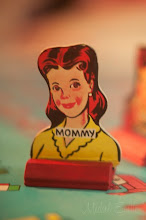I love Google's homage to Louis Daguerre this morning!! This is one of my favorite Google doodles I've seen. Louis was one of those lovely combinations of scientist and artist through which new mediums are born. When the first permanent photograph was produced in 1826 by Joseph Nicéphore Niépce, Louis worked with Niepce to further develop this process until Niepce's death in 1833. Louis went on to perfect his process and the Daguerreotype was produced in 1839 and portrait photograph is born!
Daguerreotypes were mounted, for safe keeping, in little cases, but not every case you find contains a daguerreotype- some are ambrotype and tintypes. Here are some case images from my mother's collection. I'm not sure any are daguerreotypes, but they are still beautiful little case prints.
Ambrotypes came into use in the 1850's and it was an easier process and replaced Daguerreotypes. Ambrotypes are like negatives on glass with black emulsion painted to make the negative areas black.
This little guy is out of his case, so it is easy to see, from the side this is a glass image.
In this one you can see the black backing has separated from the image.
Although looking straight on the image is easily seen.
Although this image doesn't show it, these ladies have the same thing happening.
Although I'm not positive, this seems to be another Ambrotype with some sort of damage that is making he negative 'drop' and the positive peel.
This image is housed in a "Genuine Union Case" which was made of a composite material made from sawdust.
Of course with people interested in anachronism (like Steampunkers) you can find artists online producing modern Daguerreotypes. Here are some examples:
Shiny Photos - Jonathan Danforth
Cased Image - Alan Bekhuis
Contemporary Daguerreotype Flickr Group
And Alternative Photography who I subscribe to on Facebook.
Thanks to men like Daguerre and Neipce we can preserve a tiny moment in time to have forever. So maybe Daguerre was more than Artist and Scientist. Maybe he was also Magician.



No comments:
Post a Comment